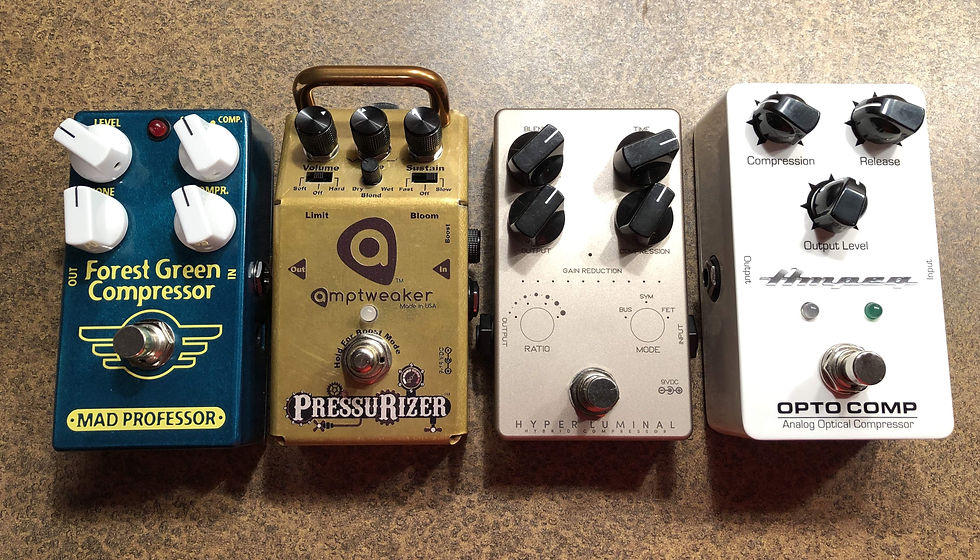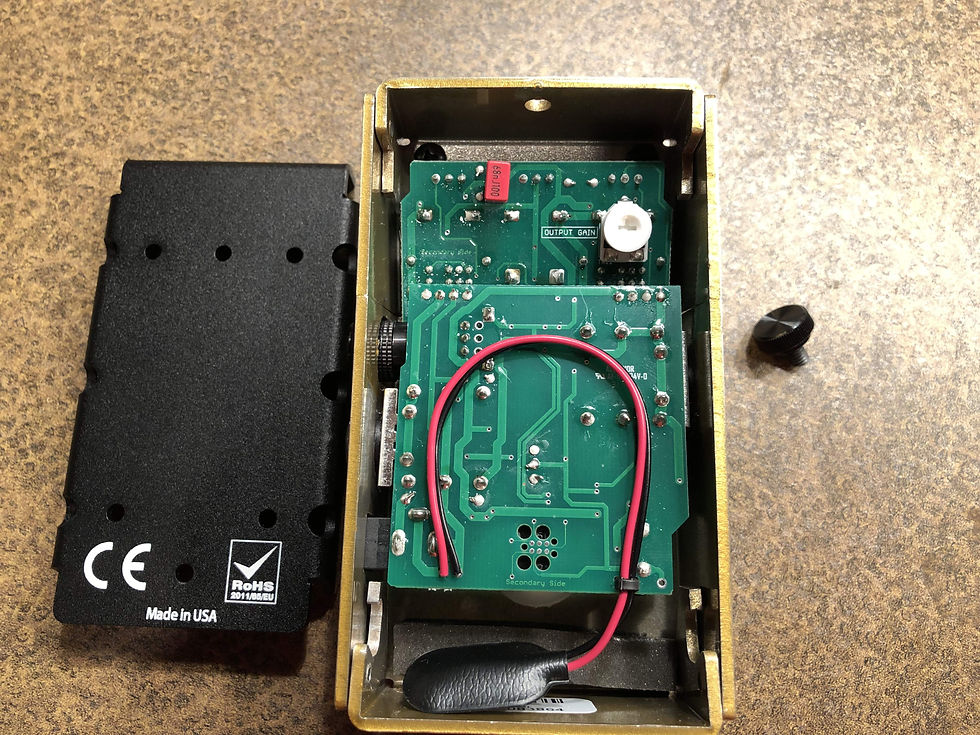The Amptweaker tagline is "good tone comes from tweaking".
The PressuRizer from Amptweaker is true to that having great tone AND a whole lot variables to tweak. It is quite unlike anything in the market I've ever experienced and I mean that in a good way. First, it's a compressor. But it's also a limiter. It's also a boost pedal. Its super power might be what is called Bloom. More on that later.

Amptweaker is the company founded by James Brown who designed amps at Peavey® for 18 years, and did some pedals there too. James mostly did guitar amps, including the Classic 50/30, the 5150, XXX, JSX, etc. but also did a few bass amps. He did a rack mount tube head called the Alphabass. He also worked at Kustom® AmpRead more about James and the company here: Amptweaker. His experience is clearly in the unique design and function of the PressuRizer.
Let's start with the functions of the PressuRizer.

The Volume knob is master volume to set the overall output volume. There is plenty of volume on tap.
The tone knob boosts the highs or cuts mids of the compressed tone. Straight up noon seems pretty neutral. Counterclockwise produces a deeper more "bassy" low mid heavy sound. Turning it more clockwise introduces more highs and seems to reduce some lows. I really liked the knob at about 11:00 for a real full, big and punchy sound. The tone knob only affects the compressed signal.
Turning the Sustain knob more clockwise increases compression and sustain. The feel is very natural and not grabby but certainly adds compression you notice. I liked the knob around 10:00 - 11:00 for subtle but noticeable and usable compression.
The Blend knob mixes dry and wet signal. All the way counter clockwise is full dry unaffected signal and fully clockwise is 100% wet affected signal. I really liked the blend at about 10:00. The blend knob is small and has a tiny notch position marker. On a pedalboard you would never be able to see where you have the dial set. I'd prefer having a larger knob and some sort of visible position marker.
The Bloom switch activates compression after the initial attack and has a fast and slow bloom setting. It offers a really unique feel when activated. Essentially it lets all of the initial attack through and then blooms in the compression either slowly (when switch is set to slow) or fast (when switch is set to fast. Don't think of it as a dip and swell type of feel. No, this is full out letting the attack through and then kicking in the compressor later. With the dry/wet dial set all the way clockwise to fully wet signal this bloom sounds very strange and unnatural. It's really unusable but that's not how it is intended to be used. Start blending in more dry signal and and you get a real nice punchy, full, and robust sound and feel. Fully wet it's kind of strange because it makes the signal completely go away when you play hard. But that lets you only hear the dry attack at first, and then the compressed signal blends in, so it just sustains without compressing the attack. When I was talking with James about the Bloom feature prior to receiving the pedal I was honestly quite skeptical. But after playing with it I really like it. Seems to add more bigness and is great with pick style playing in particular. Very natural and doesn't clamp down on that initial pick attack.
When I spoke with James, he had this to say:
"I used a THAT chip set, which is the same parts used in DBX stuff, and while tweaking it out I found I could OVER compress it enough to get the compressed signal to be basically gone. Blend it to the dry, and you get dry at first, followed by compressed signal that lasts. Plus since the Tone only affects the compressed part, it helps you dial out the mid range that compression tends to add, or make it get a little brighter as the note dies off and becomes naturally darker. The result is you can make it get louder over time like a hollow body, or you can make it sound really natural like there's nothing on there. If you crank the sustain and set it wet, it's like using an envelope follower trying to sound like a big violin swell....nothing at first and then the note comes in so you need to blend it more than half and half dry to get an even blend. If you mix it half and half, you get a bloom, hence the name. And then the output FET Limiter circuit is AFTER the blend. So it affects everything and lets you do a bit of limiting on that initial attack too."
The Limit switch activates a FET type limiter with soft or hard knee AFTER the wet/dry blend. There is an internal gain knob inside the enclosure to adjust the gain associated with the limiter. Adjusting that gain knob has a lot of affect on how the limiter interacts with your signal. How the Limit feature interacts with the Bloom feature is pretty cool too. This FET limiter has a very rounded breakup, similar to output tubes.
When you first plug in the pedal and press the true bypass foot switch it will light orange. This is standard mode. Pressing the foot switch again turns off the compressor. The foot switch is the smooth non-click variety.

On the right side of the pedal is a boost dial. All the way counterclockwise is virtually no boost (off) and all the way clockwise provides a nice amount of gain. It's boosting the effected signal so you get exactly the sound of how you've dialed in the pedal only louder. You activate the boost with the true bypass foot switch. Press and hold the switch for a couple of seconds and you've activated the pedal in boost mode on which is identified with a green LED. When the LED is lit green, the pedal is in standard operation but then tapping the foot switch once and you've activated the boost which is indicated by a red LED. Tapping the foot switch again you return to standard compressor (non boost).

The enclosure itself is metal and quite small at 2.7" wide by 4.65" long. It's about the size of the Forest Green or Hyper Luminal and less tall than the Ampeg Opto Comp. It's a unique enclosure in a few ways, not just its steampunk inspired design. First it is held shut by one threaded screw at the end of the pedal which is easy to twist open making battery changes simple and fast. Yes, the pedal will operate on a 9-volt batter. Secondly, the bottom of the enclosure has tie-wrap holes used to mount on hole style pedal boards. Nice feature.


Input/output jacks are side mounted and the 9 - 18 volt power input is located on the right side. The pedal can operate at 18 volt power and I preferred operating it at 18 volts. At 18 volts it does seem to operate with more headroom and has a different effect on the limiter function with less distortion. The manual says you will experience a more dynamic feel at 18 volts and I don't see that as a marketing gimmick. I don't think my ear was tricking me so I think it is safe to say that the pedal sounds even more open and fuller when running at 18 volts.
It is very quiet though not quite as silent as the FEA units but better than many tested already in this thread.
There is no threshold/gain reduction LED meter.

The PressuRizer is a great option for bassists desiring a multifunction compressor tuned to not mess with your attack. That can't be emphasized enough. I liked how much punch and natural compression I received but also how smooth it remained and never felt clamped down. Words like natural, flexible, dynamic, big, and smooth are keywords describing the PressuRizer in my opinion. I really enjoyed tweaking it and found so many usable and dynamic tones and compression types. Emphasis on "tweaking" though I quickly found that "tone in my head" which for me meant Tone at 11:00, Sustain at 10:30, Blend at 10:00, Limiter off, and Bloom on slow. It might seem complicated but with a little time there is a lot of versatility and unique tone shaping on tap. People who want a little compressed distortion will dig the limiter function, especially at 9 volts. I wouldn't describe it as a transparent compressor especially since there is considerable interaction between the Bloom control, limiter (the breakup colors the tone), and sustain. There is coloration but to my ear, it is pleasing.
I had no issue with headroom with any of my basses. It's not the most simple compressor to operate but is rewarding to dial in. The Amptweaker PressuRizer makes for a very nice sounding and performing always on compressor/limiter + boost, albeit a bit unconventional.

